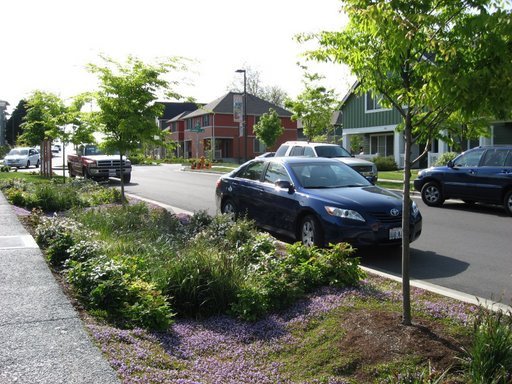Green Street Practices
What are green street practices?
Green street practices are select green infrastructure elements, such as bioswales, rain gardens, and permeable pavement, that can be incorporated into a traditional street design to create a "Green Street". Green street practices capture, retain, treat, and/or infiltrate stormwater runoff from impervious surfaces such as roadways, parking lots, sidewalks, and rooftops.
How do green street practices protect water quality?
The Issue - Stormwater Runoff
Stormwater runoff is one of the largest sources of water pollution in urban and suburban areas and presents many environmental, social, and economic challenges to communities across the nation. Rainwater that runs off impervious surfaces, such as roadways, rooftops, and parking lots, collects pollutants like oil and grease, animal waste, metals, trash, sediment, and nutrients. Ultimately, the contaminated stormwater runoff is discharged into local waterbodies, directly impacting the water quality of local water bodies.
Along with pollution concerns, impervious surfaces may lead to increased flooding. More frequent and intense rain events in highly impervious areas can overwhelm stormwater collection systems leading to recurrent localized flooding. Flooding can have significant economic impacts on communities due to loss of property and damage to critical infrastructure such as utilities, roads, and bridges. An increase in the volume of water discharging into streams and rivers leads to stream bank erosion, sedimentation, and loss of stream stability. For more information on how to manage your community's flood risk, please visit our Green Infrastructure Manage Flood Risk webpage.
Stormwater Collection Systems
In urban areas stormwater runoff is directed into either:
- Municipal Separate Storm Sewer Systems (MS4s). MS4s are designed or used to collect or convey stormwater (e.g., storm drains, pipes, ditches) that often discharge untreated stormwater into local water bodies. To learn more about MS4s, please visit EPA's Stormwater Discharges from Municipal Sources page.
- Combinded Sewer System (CSS). A CSS collects rainwater runoff, domestic sewage, and industrial wastewater into one pipe. Under normal conditions, it transports all of the wastewater it collects to a sewage treatment plant for treatment, then discharges to a water body. The volume of wastewater can sometimes exceed the capacity of the CSS or treatment plant (e.g., during heavy rainfall events or snowmelt). When this occurs, untreated stormwater and wastewater, discharges directly to nearby streams, rivers, and other water bodies. To learn more, please visit EPA's Combined Sewer Overflows (CSOs) page.
The Solution - Green Streets

A street-side swale and adjacent porous concrete sidewalk located in the High Point neighborhood of Seattle, WA (Source: Abby Hall, US EPA).

Implementing a G3 Approach and incorporating green street practices help manage stormwater where it falls and keeps it from entering stormwater collection systems. Green street practices can address the environmental and human health concerns associated with stormwater runoff from impervious surfaces by:
- reducing the discharge of pollutants into waterways
- mitigating the effects of flooding
- preventing stream bank erosion
- increasing stream stability and ecological health
To learn more about additional green infrastructure practices, please visit EPA's What Is Green Infrastructure? and Water Environment Research Foundation's Green Streets Basics and Design .
